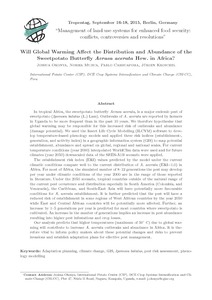In tropical Africa, the sweetpotato butterfly Acraea acerata, is a major endemic pest of sweetpotato (Ipomoea batatas (L.) Lam). Outbreaks of A. acerata are reported by farmers in Uganda to be more frequent than in the past 10 years. We therefore hypothesise that global warming may be responsible for this increased risk of outbreaks and abundance (damage potential). We used the Insect Life Cycle Modelling (ILCYM) software to develop temperature-based phenology models and applied three risk indices (establishment-, generation, and activity index) in a geographic information system (GIS) to map potential establishment, abundance and spread on global, regional and national scales. For current temperature conditions (year 2000) interpolated WorldClim data were used and for future climates (year 2050) downscaled data of the SRES-A1B scenario were applied.
Will global warming affect the distribution and abundance of the sweetpotato butterfly Acraea acerata Hew. in Africa?
Citation: Okonya, J.; Mujica, N.; Carhuapoma, P.; Kroschel, J. 2015. Will global warming affect the distribution and abundance of the sweetpotato butterfly Acraea acerata Hew. in Africa?. Tropentag 2015. Management of land use systems for enhanced food security: Conflicts, controversies and resolutions. Berlin (Germany). 16-18 Sep 2015.
2015-11-10
SWEETPOTATOES
Eastern Africa
Uganda
poster_abstract

